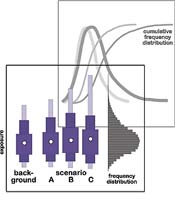 |
Ecotoxicological Assessment
Legal maximum concentration limits or standard and reference values for environmental pollutants are only available for a limited number of substances.
They serve as scales to assess and evaluate the impact of pollutants to the environment, e.g. air, water, soil and food. On this basis, potential risks for human health and for the environment can be deduced and abatement measures can be recommended.
For many substances that might pose hazards to the environment standardized levels and reference values have not been evaluated and published to an adequate extent. Interactive effects of combinations of several pollutants - a situation most commonly encountered under realistic conditions - are generally not considered by most of the current standards and limits.
Based on available expert knowledge from present scientific sources, in most cases an estimate or provisional assessment can be made for possible risks to man's health and the environment. This is achieved through searches of international scientific literature and documentation. Further steps of evaluation comprise the assessment of exposure and risks.
International on-line databases, updated on a weekly or monthly basis, as well as extensive, directly accessible databases enable fast screening of relevant information and the selection of relevant articles. In this way, critical and current information on toxic and ecotoxic properties can be found even for poorly documented substances.
|
 |

Graphical presentation of environmental levels of pollutants and their toxic
and ecotoxic effects
|
|
Pollutant uptake into an organism and its fate are assessed in exposure assessment. The content and flow of pollutants in various environmental media as well as the subject's behaviour (choice and intake of food, time spent indoors and outdoors, etc.) are crucial factors determining the exposure, which are linked in exposure models.
All influential variables in pollutant exposure models can vary by large or narrow margins and are biased by various degrees of uncertainty. Thus, frequency distributions are more appropriate than fixed values to describe those variables. These distributions of frequency or probability values are linked in probabilistic exposure assessment, resulting in a more realistic estimate of pollutant exposure and reflecting the variability and uncertainty of the results.
Potential health risk to man and ecological risks of pollutant exposures are estimated by risk assessment. Current progress in exposure and risk models as well as improvements in the underlying databases largely increase the feasiblity of probabilistic risk assessment in recent years. Thus, not only the risk values themselves, but also their distribution and uncertainty may be estimated more realistically.
|
|

Probabilistic exposure assessment allow comparison of pollutant exposure under various scenarios and provide information on variability and uncertainty
|
|